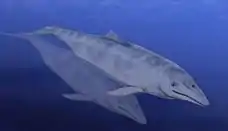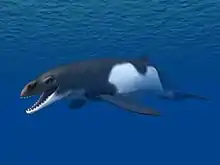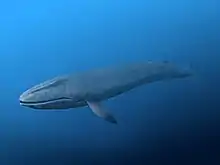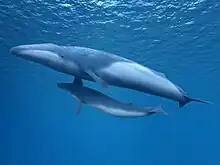| Eomysticetus Temporal range: Chattian | |
|---|---|
| Scientific classification | |
| Domain: | Eukaryota |
| Kingdom: | Animalia |
| Phylum: | Chordata |
| Class: | Mammalia |
| Order: | Artiodactyla |
| Infraorder: | Cetacea |
| Family: | †Eomysticetidae |
| Genus: | †Eomysticetus Sanders and Barnes, 2002 |
| Species | |
|
†E. carolinensis Sanders and Barnes, 2002 | |
Eomysticetus is an extinct genus of baleen whale from the late Oligocene (Chattian) Chandler Bridge Formation of South Carolina.[1]
Taxonomy
Eomysticetus is a member of the family Eomysticetidae, which also includes Micromysticetus, Tohoraata, Tokarahia, and Yamatocetus.[2] There are two species of Eomysticetus, E. whitmorei and E. carolinensis, both from the Chandler Bridge Formation of South Carolina.[1]
Physical characteristics
The skull was around 1.5 metres (4.9 ft) in length.[3] Like more evolved baleen whales, its jaws had baleen instead of teeth, meaning that it could filter plankton with its baleen plates.[4][5][6][7] However, primitive baleen whales may have retained enamel coated teeth embedded in the gums, similar to modern sperm whales.[8] Baleen whales, as a group, may be sensitive to low-frequency sounds.[9]
Unlike modern baleen whales, Eomysticetus had a blowhole that was positioned ahead of the eyes, and the characteristics of its vertebrae and flipper bones are akin to those of archaeocetes like Basilosaurus.[4]
References
- 1 2 Sanders, A. E.; Barnes, L. G. (2002). "Paleontology of the Late Oligocene Ashley and Chandler Bridge Formations of South Carolina, 3: Eomysticetidae, a new family of primitive mysticetes (Mammalia: Cetacea)". In Emry, R. J. (ed.). Cenozoic Mammals of Land and Sea: Tributes to the Career of Clayton E. Ray. Vol. 93. pp. 313–356. hdl:10088/22502.
{{cite book}}:|journal=ignored (help) (148Mb) - ↑ Boessenecker, Robert W. "Dissertation research on archaic fossil baleen whales (Eomysticetidae) from the Oligocene of New Zealand". Retrieved 12 October 2014.
- ↑ Berta, A.; Deméré, T. A. (2009). "Mysticetes, Evolution". Encyclopedia of Marine Mammals. pp. 751–752. doi:10.1016/B978-0-12-373553-9.00175-9. ISBN 9780123735539.
- 1 2 "Eomysticetus whitmorei". NYIT College of Osteopathic Medicine. Retrieved 12 October 2014.
- ↑ Y. Okazaki. 2012. A new mysticete form the upper Oligocene Ashiya Group, Kyushu, Japan and its significance to mysticete evolution. Bulletin of the Kitakyushu Museum of Natural History and Human History Series A (Natural History) 10:129-152
- ↑ Boessenecker, R. W., Fordyce, R. E. (2014), A new Eomysticetid (Mammalia: Cetacea) from the Late Oligocene of New Zealand and a re-evaluation of ‘Mauicetus’ waitakiensis. Papers in Palaeontology. doi: 10.1002/spp2.1005
- ↑ Robert W. Boessenecker and R. Ewan Fordyce (2015). "A new genus and species of eomysticetid (Cetacea: Mysticeti) and a reinterpretation of ‘Mauicetus’ lophocephalus Marples, 1956: Transitional baleen whales from the upper Oligocene of New Zealand". Zoological Journal of the Linnean Society. in press. doi:10.1111/zoj.12297.
- ↑ Meredith, R. W.; Gatesy, J.; Cheng, J.; Springer, M. S. (2011). "Pseudogenization of the tooth gene enamelysin (MMP20) in the common ancestor of extant baleen whales". Proceedings of the Royal Society B. 278 (1708): 993–1002. doi:10.1098/rspb.2010.1280. JSTOR 41148721. PMC 3049022. PMID 20861053.
- ↑ Ekdale, E. G. (2016). "Morphological variation among the inner ears of extinct and extant baleen whales (Cetacea: Mysticeti)". Journal of Morphology. 277 (12): 1599–1615. doi:10.1002/jmor.20610. PMID 27627739. S2CID 24764616.



